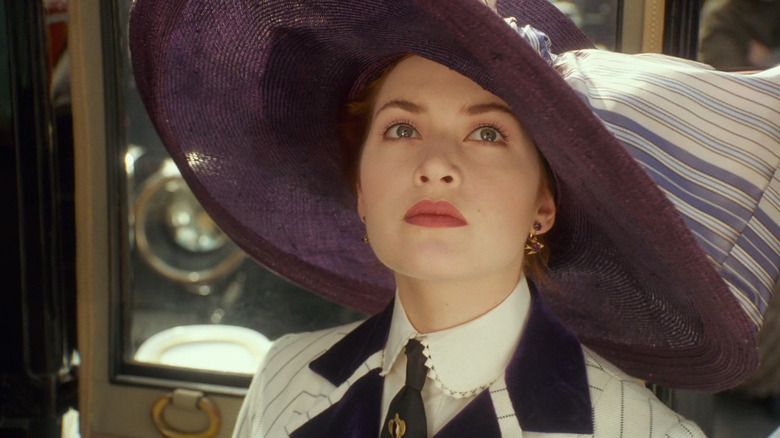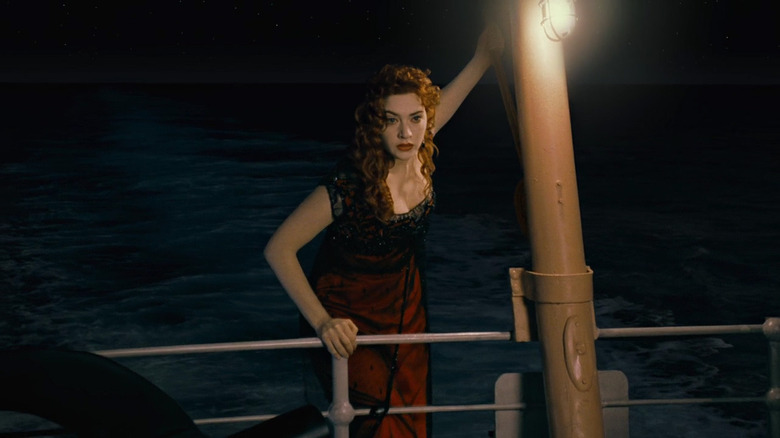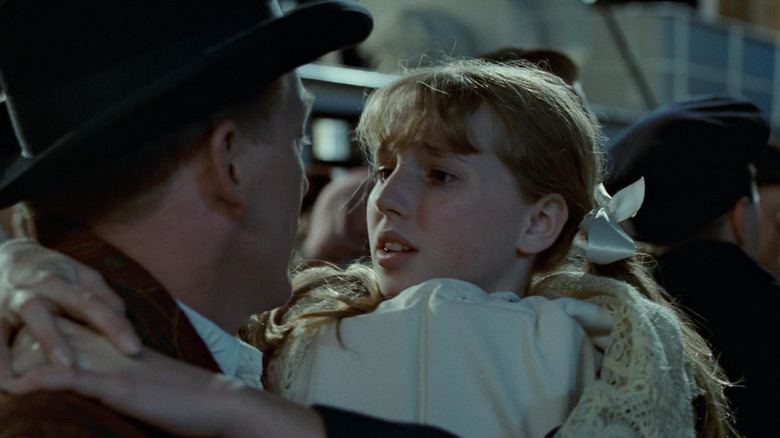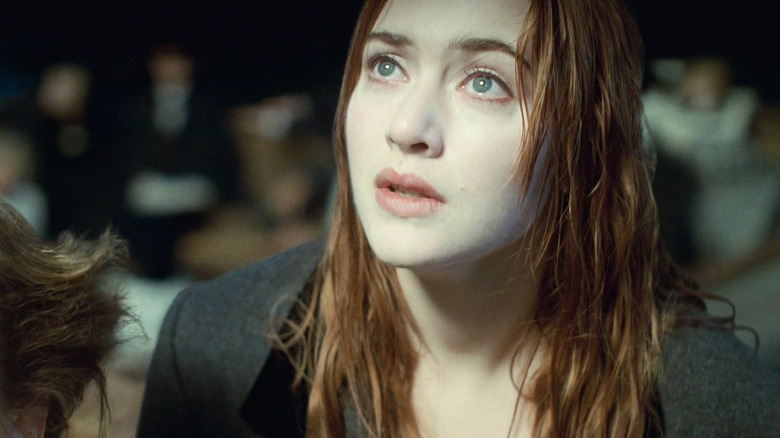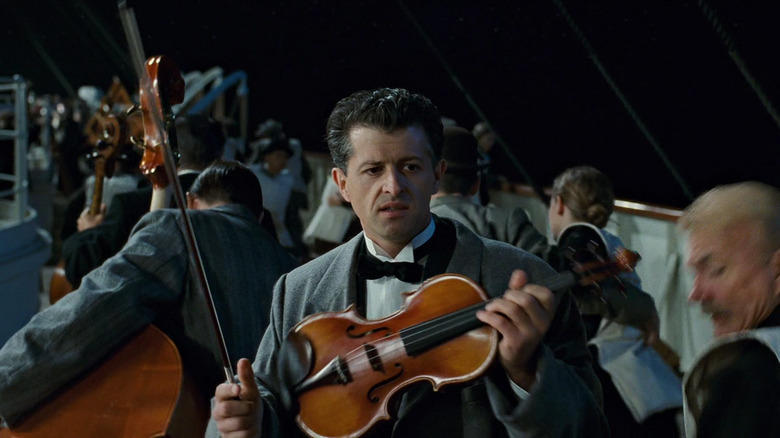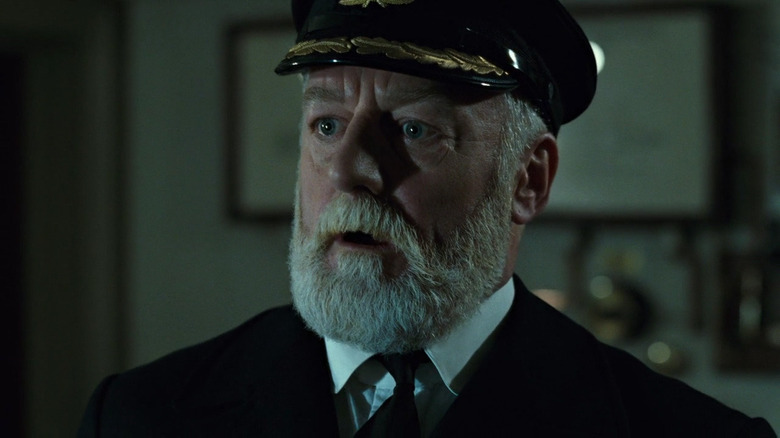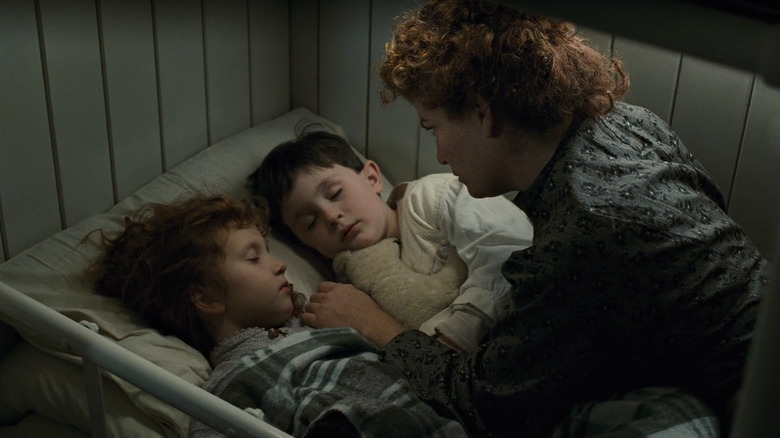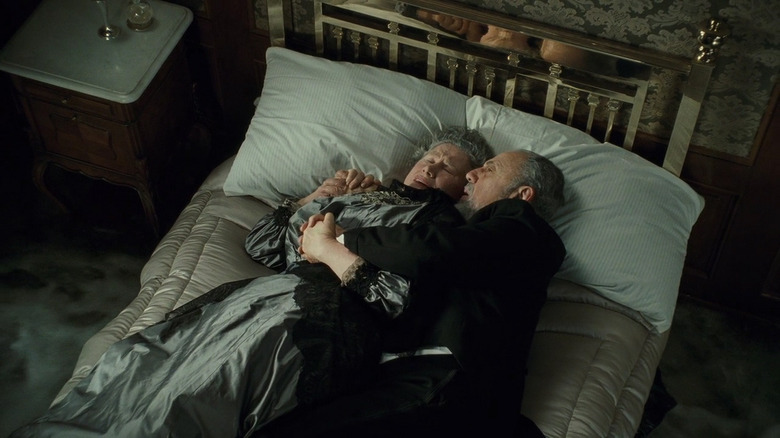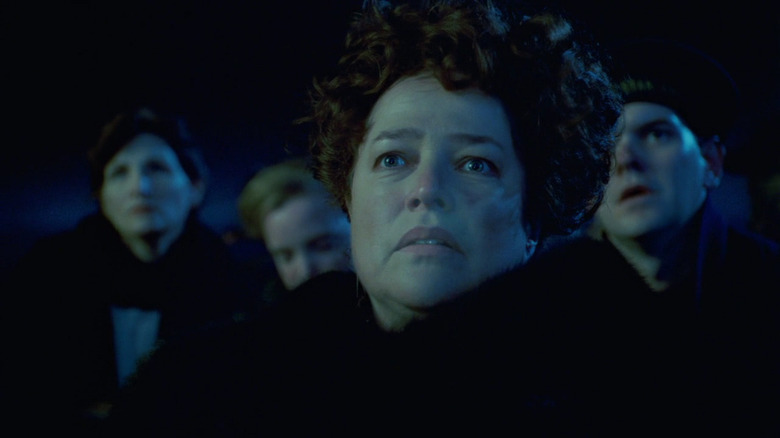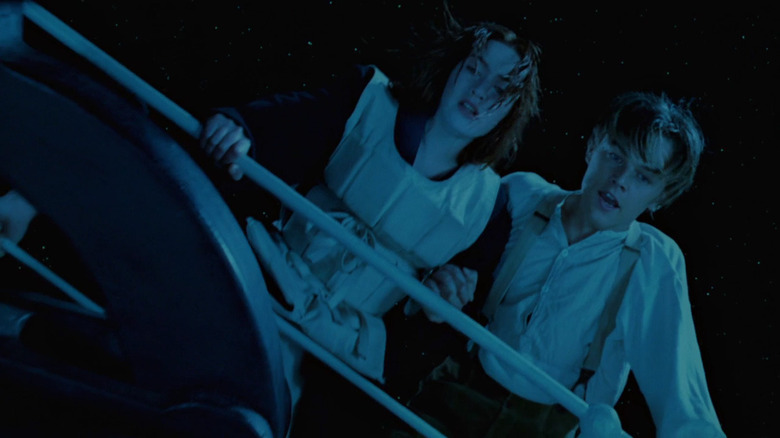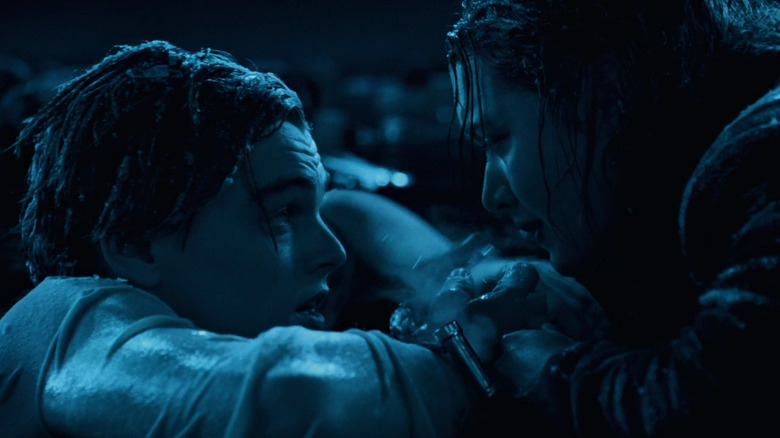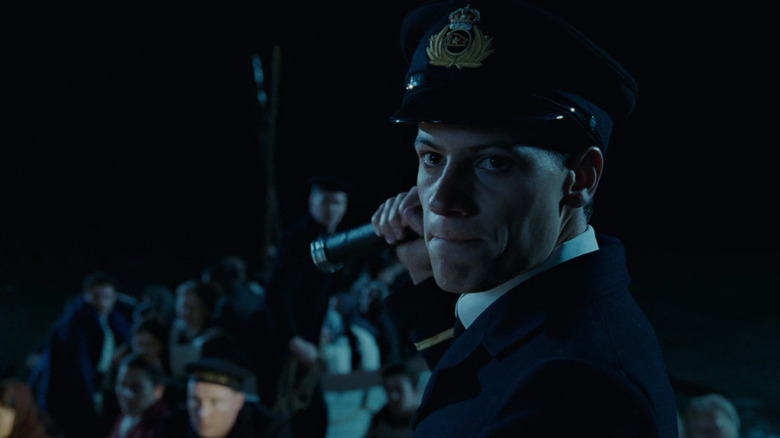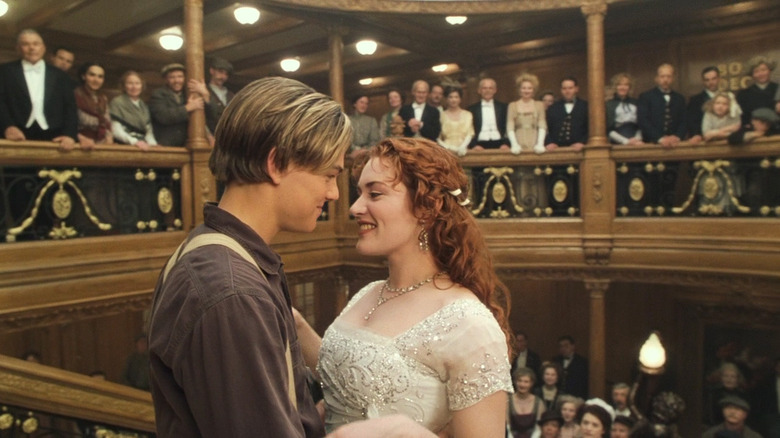The 12 Saddest Moments In Titanic
You can be a hater all you want, but you can't deny the truth: James Cameron's "Titanic" – returning to theaters soon for its 25th anniversary – is one of the most epic romances in film history. Though it only lasts a few days, Rose (Kate Winslet) and Jack's (Leonardo DiCaprio) relationship has been enchanting audiences for decades. As Rose puts it, Jack "saved me in every way that a person can be saved." While "Titanic" has a moderately hopeful message, it's also profoundly sad. (Given the historical influence, how could it not be?)
At this point, it's fair to say that you know how "Titanic" ends if you're reading this article. But in case you forgot: Jack doesn't survive. But he was far from the only one with this fate. More than 1,500 people died during the real-life sinking of the Titanic. While much of the movie details the joy and excitement of first love, "Titanic" becomes a disaster film in its latter half.
Despite the large-scale nature of the tragedy, many of the most heartbreaking scenes in "Titanic" focus on individual people and their attempts to survive. Due to the film's lengthy runtime, several moments are worthy of your tears. Here's my inventory of the 12 saddest moments in Cameron's "Titanic."
Rose attempts suicide
When most people think of the saddest moments in "Titanic," their mind probably goes to the last third of the movie when the Titanic starts sinking. What fans forget is that things weren't exactly peachy for our main characters before the ship went down. Despite her position of privilege, Rose is extremely unhappy with her life and feels trapped in her engagement with Cal (Billy Zane).
Rose dreads the life planned for her, which leads her to attempt suicide early in the film. Jack finds her at the back of the boat, readying to jump. He talks her down by regaling her with tales of ice fishing in Wisconsin. Jack reminds her how cold the water is and threatens to jump in after her if she goes over. He succeeds in saving her (the first of several instances), and for a moment, all is well.
Cal's arrival interrupts Jack and Rose's brief happiness. He assumes something untoward has happened between Rose and Jack, offering Jack a measly twenty dollars for saving Rose before whisking his poor fiancée away. Although she's reclaimed her life, Rose remains just as trapped as she was before.
If you or anyone you know is having suicidal thoughts, please call the National Suicide Prevention Lifeline by dialing 988 or by calling 1-800-273-TALK (8255).
They'll be another boat for the Daddies
Though Jack and Rose are the most important characters in "Titanic," the ship contained more than 2,000 other passengers. We're given some brief insights into these passengers' lives when the Titanic sinks in the last chunk of the film. Despite the film's protracted runtime, some of its most affecting moments are these fleeting glimpses.
One such moment involves the ship's lifeboats. Early in the film, we learn they can only fit about half of the ship's passengers. During the ship's sinking, a crew member picks up a young girl and hands her to her mother, who is sitting in a lifeboat with her other daughter. The girl doesn't want to leave her father's arms, but he reassures her it will be okay. "It's goodbye for a little while," he said. "Only for a little while. There'll be another boat for the daddies."
Of course, we (and this man) know there will not be "another boat for the daddies." Like this will be the last time they see each other, and it's a heartbreaking illustration of a man trying to protect his children until the end. But its brevity doesn't dilute its emotional power. Rose also bears witness to this family's separation, and it's one of the things that spurs her into (probably ill-advised) action moments later.
Rose jumps back on the ship
"You're so stupid" might not sound like the defining line of an epic love story, but in the case of Jack and Rose, it marks an essential turning point for their relationship. After witnessing a father being separated from his children moments earlier, Jack tells Rose it's her turn to board the lifeboat. Cal arrives and tells Rose the same: It's the only instance in the film where Cal and Jack find themselves on the same side.
Initially, Rose acquiesces to their demands. But then, after an extended sequence of Jack and Rose looking at each other while the "Titanic" theme plays, Rose makes what is most certainly one of the most foolish decisions in the film. She can't bear separating from Jack, so she jumps back on the ship at the last moment, and Jack races down the stairs to greet her.
This moment is when we get the "you're so stupid" line, which is right on the money. Technically, it's an instance of two star-crossed lovers reuniting, but we all know things will only get worse from here. Rose knows she may have signed her death warrant, as does Jack. But they allow themselves a brief moment of joy before things go to hell, which makes everything feel more tragic.
The band plays one last song
Many of the most affecting scenes in the latter part of "Titanic" depict individuals trying to maintain their dignity in the face of a horrific disaster. While some – Cal, for one – are willing to step on others to survive, others accept their fate with more grace. A great example of this is the band on board the Titanic. We see four men on the deck finishing up what they assume will be their last song before the ship sinks. But as the men begin to walk away, a violin player (Jonathan Evans-Jones) starts up another song – "Nearer, My God, to Thee."
His fellow musicians hear the music and stop in their tracks, turning around one by one to join in on the song. People scream and run around the deck, but the band plays on — perhaps to calm the passengers or themselves. This song accompanies one of the most moving montages in the entire film, as passengers from all walks of life come face to face with death.
Like many moments in "Titanic," one of the things that makes this scene moving is its tie to real-life events. According to BBC, musicians aboard the ship played for nearly two hours after the iceberg hit. Whether or not "Nearer, My God, to Thee" was their final song remains contested, but it was a fitting choice for the film.
The Captain goes down with his ship
Cameron's "Titanic" makes it quite clear who the villain of this story is. Bruce Ismay (Jonathan Hyde) is the managing director of the White Star Line, and he tells the crew to increase the ships' speed so that they will have a grand entrance and make the papers. As the film tells it, the ship's high speed meant they didn't see the iceberg in time, which resulted in the hull's breach.
While you might be inclined to blame Captain (Bernard Hill) for the shipwreck, "Titanic" asks us to sympathize with him. And have sympathy we do, as the Captain's dignified death is a moving part of the film. When it's obvious there's nothing more that can save the ship, the Captain returns to the helm to steer the boat until the very end.
When he arrives to steer, the room is filling up with water. But he remains steadfast in his commitment to going down with the ship. When he hears the windows rumble, he takes a deep breath in preparation. Moments later, the windows break, and he presumably dies shortly after. Unlike Ismay (Jonathan Hyde), who escapes the disaster like a coward, Captain Smith confronts his fate head-on, bringing tears to the eyes of many viewers.
A mother reads her children a bedtime story
The montage in "Titanic" while the band is playing their final song on the deck is one of the saddest montages in cinema history — full of pathos and poignancy. The Captain's last stand is one such moving sequence, but few moments are as heartbreaking as the one depicting a mother and her children.
Class distinctions are an important theme in "Titanic," as the film shows how first-class passengers had preferential treatment — leading to the deaths of many poor passengers in the lower cabins. While some passengers fought to get to the upper decks – we see Jack and Rose join in this fight at one point – others decided to stay put.
A brief but touching sequence depicts an Irish woman putting her two children to sleep in their bunk with a bedtime story. Jenette Goldstein, who plays the mother, told Good Housekeeping that one of the Irish actors on set suggested she tell the story of Tír na nÓg, which describes "the land of eternal youth and beauty" where no one becomes ill or dies. For this scene, it's a fitting story, as the mother is doing everything she can to protect her children from their cruel fates.
The elderly couple that doesn't make it
Though "Titanic" is full of grand set pieces and dramatic action, some of the most moving moments in the film only last a few seconds. For example, sandwiched between the Captain returning to the hull and the mother putting her children to bed is another glimpse of a story sadly cut short. The brief scene depicts an older man and a woman in bed together as the water rushes into their room. The man holds the woman around the waist and kisses her on the cheek as they await their deaths.
The scene is affecting as is, but it's even more tragic when you discover the real elderly couple who inspired this "Titanic" scene. While many characters trapped in their rooms are lower-class passengers, the couple here is a fictitious version of Isidor and Ida Straus, first-class passengers who remained on the ship. Isidor was the co-owner of Macy's department store, and their grandson, Paul A. Kurzman, shared their tragic story.
According to Kurzman, Ida initially boarded a lifeboat but decided to reboard the ship when she realized her husband couldn't join her. Ida then gave her maid a fur coat and told her to get on a lifeboat while she stayed on the ship with her husband, where they both died. The National Archive reports they were last seen holding hands on the deck.
Molly Brown wants to save more lives
One of the greatest tragedies surrounding the Titanic's sinking is how poor planning cost more lives. The first problem is that there were not enough lifeboats to fit all the passengers. But they didn't even use the available lifeboats to their full potential. Almost every lifeboat left the ship underfilled, with the first lifeboat containing only 28 passengers when it could carry 65, according to History.com.
These real-life events are dramatized in the film when the Titanic's most famous survivor calls attention to the discrepancy. Molly Brown (Kathy Bates) – known as the "The Unsinkable Molly Brown" following the disaster – finds herself in a lifeboat that can fit more people. Molly implores the crewman on the lifeboat to go back and take more passengers, but he tells her that will "swamp the boat." Molly becomes appalled by everyone's lack of action, and she implores the other women on the lifeboat to grab an oar and row, but none do. "I don't understand a one of you. What's the matter with you?" She asks.
The reason this scene is so powerful is because of everything it represents. We know from watching the film how many more people they could have saved, and seeing this deadly indifference in action is horrifying. Moreover, Molly Brown is one of the most entertaining characters in the film, and Bates does an admirable job imbuing this larger-than-life figure with a pathos that brings her back down to earth.
The ship finally sinks
One of the most dramatic parts of "Titanic" is how long the disaster lasts. As Thomas Andrews (Victor Garber) tells the captain earlier in the film, the ship takes about two hours to sink after a breach. During the film's climactic moment, the ship breaks in half. The bow dips into the water, causing the stern to tilt upwards at a terrifying angle.
This scene contains more carnage than any other scene in the film: People slide down the boat while others jump off the edge. As the ship becomes more and more vertical, the violence increases, with people crashing to their deaths with blood-curdling screams ringing out. The loss of life depicted in this scene alone is enough to give you the shivers, and the horror on Rose's face as she watches it unfold mirrors our own.
Luckily, Jack and Rose stay on the boat until the very end due to some quick thinking by Jack. He tells Rose to climb onto the railing until the ship goes under — a mournful reprise of the earlier scene where Jack saves Rose from taking her life. This time, she wants to live with him.
Jack freezes to death
No scene in "Titanic" is more controversial than the final scene between Jack and Rose. Couldn't they both have fit on that door? Is Rose responsible for Jack's death? Perhaps these are interesting questions if you're a physicist, but we're not here to answer them. It doesn't matter if Jack could have fit on the door because Jack has to die – that's the point of the whole movie.
Even if Jack's death is inevitable, that doesn't make it any less sad. Jack's sacrifice for Rose is just as moving today as it was 25 years ago. After ensuring Rose is safe atop the floating door, Jack tells Rose about her wonderful future. "You're gonna make lots of babies. And you're gonna watch them grow," he tells her.
Cue the most famous line in the film: Jack tells Rose to "never let go." Except he's not telling her never to let go of him – something she must do in a few short minutes – but rather to never let go of the promise she's made to him to survive. She almost does give up when she realizes Jack has died. However, she remembers the promise she made and musters up all the energy she has left to yell for the lifeboat. The look on Rose's face when Jack doesn't respond is heartbreaking, but her courage prevails.
The rescue attempt that comes far too late
Though Rose is the only character we follow after the events of the disaster, other survivors had their lives irrevocably changed after that night. Many who survived witnessed horrors that no one should ever have to see. "Titanic" makes us privy to some of these horrors, such as in the scene depicting a (mostly) failed rescue attempt.
As the scene with Molly Brown so effectively illustrates, there was plenty of room on the lifeboats, but almost no one returned to retrieve more passengers. The only officer that went back to look for survivors was Fifth Officer Lowe (Ioan Gruffudd), who steered his lifeboat into a group of floating bodies. What he finds there is nothing short of horrific. The bodies are frozen solid, though Lowe still instructs the other passengers to check to see if anyone is alive. The most shocking sight is a frozen woman and baby. "We waited too long," Officer Lowe says.
Still, there is one bright spot at the end of this scene. Of course, there is one survivor in the group: Rose. Thankfully, she alerts the boat to her presence.
Jack and Rose finally reunite
Rose agrees to help the researchers with their mission to re-discover the Titanic to receive closure. She's kept her experiences to herself for years, and finally sharing them with the researchers and her granddaughter gives her the sense of peace she's been seeking. At the film's end, Rose drops the Heart of the Ocean – which she's kept all this time – into the deep sea, signaling that she's finally ready to let go.
Afterward, Rose goes to sleep in her bed and dies in her sleep or has a heavenly dream — depending on your perspective. Rose has brought her picture frames with her, illustrating all of the adventurous things she did in her life and indicating that she kept her promise to Jack. The camera then plunges into the ocean and moves through the halls of the decrepit ship, only for the Titanic to suddenly be restored to its former glory. A young Rose walks into the ballroom and sees Jack waiting for her there on the staircase, where they lovingly embrace.
Whether or not you think Rose has died or is just dreaming, it's still a bittersweet moment. Jack and Rose never truly got to be together in life, and he's only ever existed in her mind – until now, of course. Even if it's a dream, it's a beautiful conclusion to their ill-fated love story.
